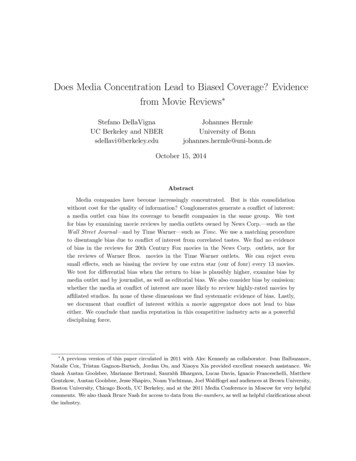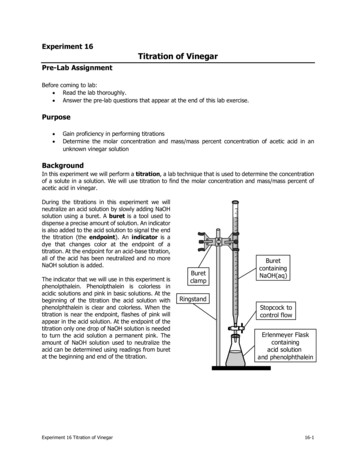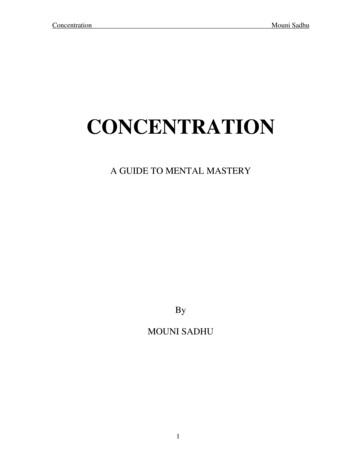
Transcription
Does Media Concentration Lead to Biased Coverage? Evidencefrom Movie Reviews Stefano DellaVignaUC Berkeley and NBERsdellavi@berkeley.eduJohannes HermleUniversity of Bonnjohannes.hermle@uni-bonn.deOctober 15, 2014AbstractMedia companies have become increasingly concentrated. But is this consolidationwithout cost for the quality of information? Conglomerates generate a conflict of interest:a media outlet can bias its coverage to benefit companies in the same group. We testfor bias by examining movie reviews by media outlets owned by News Corp.–such as theWall Street Journal–and by Time Warner–such as Time. We use a matching procedureto disentangle bias due to conflict of interest from correlated tastes. We find no evidenceof bias in the reviews for 20th Century Fox movies in the News Corp. outlets, nor forthe reviews of Warner Bros. movies in the Time Warner outlets. We can reject evensmall effects, such as biasing the review by one extra star (our of four) every 13 movies.We test for differential bias when the return to bias is plausibly higher, examine bias bymedia outlet and by journalist, as well as editorial bias. We also consider bias by omission:whether the media at conflict of interest are more likely to review highly-rated movies byaffiliated studios. In none of these dimensions we find systematic evidence of bias. Lastly,we document that conflict of interest within a movie aggregator does not lead to biaseither. We conclude that media reputation in this competitive industry acts as a powerfuldisciplining force. A previous version of this paper circulated in 2011 with Alec Kennedy as collaborator. Ivan Balbuzanov,Natalie Cox, Tristan Gagnon-Bartsch, Jordan Ou, and Xiaoyu Xia provided excellent research assistance. Wethank Austan Goolsbee, Marianne Bertrand, Saurabh Bhargava, Lucas Davis, Ignacio Franceschelli, MatthewGentzkow, Austan Goolsbee, Jesse Shapiro, Noam Yuchtman, Joel Waldfogel and audiences at Brown University,Boston University, Chicago Booth, UC Berkeley, and at the 2011 Media Conference in Moscow for very helpfulcomments. We also thank Bruce Nash for access to data from the-numbers, as well as helpful clarifications aboutthe industry.
1IntroductionOn Dec. 13, 2007, News Corp. officially acquired Dow Jones & Company, and hence the WallStreet Journal, from the Bancroft family. The acquisition was controversial in part because ofconcerns about a conflict of interest. Unlike the Bancroft family whose holdings were limitedto Dow Jones & Company, Murdoch’s business holdings through News Corp. include a movieproduction studio (20th Century Fox), cable channels such as Fox Sports and Fox News, andsatellite televisions in the Sky group, among others. The Wall Street Journal coverage ofbusinesses in these sectors may be biased to benefit the parent company, News Corp.The Wall Street Journal case is hardly unique. Media outlets are increasingly controlled bylarge corporations, such as Comcast, which owns NBC and Telemundo, the Hearst Corporation,which owns a network of newspapers and ESPN, and Time Warner, which owns HBO, CNN,and other media holdings. Indeed, in the highly competitive media industry, consolidationwith the ensuing economies of scale is widely seen as a necessary condition for survival.But is this consolidation without cost for the quality of coverage given the induced conflictof interest? Addressing this question is important, since potential biases in coverage cantranslate into a policy concern in the presence of sizeable persuasion effects from the media(e.g., DellaVigna and Kaplan, 2007; Enikolopov, Petrova, and Zhuravskaya, 2011).Yet should we expect coverage to be biased due to consolidation? If consumers can detectthe bias in coverage due to cross-holdings and if media reputation is paramount, no bias shouldoccur. If consumers, instead, do not detect the bias perhaps because they are unaware of thecross-holding, coverage in the conglomerate is likely to be biased.Despite the importance of this question, there is little systematic evidence on distortions incoverage induced by cross-holdings. In this paper, we study two conglomerates–News Corp.and Time-Warner–and measure how media outlets in these groups review movies distributedby an affiliate in the group–such as 20th Century Fox and Warner Bros. Pictures, respectively.The advantage of focusing on movie reviews is that they are frequent, quantifiable, and arebelieved to influence ticket sales (Reinstein and Snyder, 2005), with monetary benefits to thestudio distributing the movie. As such, they are a potential target of distortion by the mediaconglomerate.To identify the bias, we adopt a difference-in-difference strategy. We compare the reviewof movies distributed by 20th Century Fox by, say, the Wall Street Journal to the reviews byoutlets not owned by News Corp. Since the Wall Street Journal may have a different evaluationscale from other reviewers, we use as a further control group the reviews of movies distributedby different studios, such as Paramount. If the Wall Street Journal provides systematicallymore positive reviews for 20th Century Fox movies, but not for Paramount movies, we inferthat conflict of interest induces bias.Still, a legitimate worry is that this comparison may capture correlation in taste, rather1
than bias. The Wall Street Journal may provide more positive reviews to, say, action movies ofthe type produced by 20th Century Fox because this reflects the tastes of its audience or of itsjournalists, not because of conflict of interest. In general, correlation in tastes is a complicatedconfound because of the difficulty in identifying the comparison group. One would like to knowwhich Paramount movies are similar to the 20th Century Fox and Warner Bros. movies.For this reason, we use the extensive Netflix, Flixster, and MovieLens data sets of usermovie ratings to find for each 20th Century Fox and Warner Bros. movie the ten movies withthe closest user ratings. We document that this matching procedure identifies similar movies:matching movies are likely to share the genre, the MPAA rating, and the average rating bymovie reviewers, among other characteristics. We thus use the reviews of these matchingmovies as comparison group.We start from a data set of over half a million reviews for movies released from 1985 (yearin which News Corp. acquired 20th Century Fox) until 2010 (year in which the user ratingsdata ends). The data sources are two online aggregators, Metacritic and Rotten Tomatoes.We compare the reviews by 336 outlets with no conflict of interest (known to us) to the reviewsissued by 12 media outlets with cross-holdings. Eight media outlets are owned by News Corp.during at least part of the sample–the U.S. newspapers Chicago Sun-Times (owned until1986), New York Post (owned until 1988 and after 1993), and Wall Street Journal (ownedfrom 2008), the U.K. newspapers News of the World, Times and Sunday Times, the weeklyTV Guide (owned from 1988 until 1999) and the website Beliefnet (from 2007 to 2010). Fourmedia outlets are owned by Time Warner–the weekly magazines Entertainment Weekly andTime as well as CNN and the online service Cinematical (owned from 2004 until 2009).We provide six pieces of evidence on the extent, type, and channel of bias. In the first test,we compare the reviews of movies produced by the studios at conflict of interest to the reviewsof the ten matching movies. In a validation of the matching procedure, the average ratings forthe two groups of movies are nearly identical when reviewed by media outlets not at conflictof interest. We thus estimate the extent of bias in outlets at conflict of interest, such as theWall Street Journal and Time magazine.We find no evidence of bias for either the News Corp. or Time Warner outlets. In thebenchmark specification we estimate an average bias of -0.2 points out of 100 for News Corp.and of 0 points for Time Warner. The richness of the data ensures quite tight confidenceintervals for the finding of no bias. We can reject at the 95% level a bias of 1.9 points for NewsCorp. and of 1.7 points for Time Warner, corresponding to a one-star higher review score (ona zero-to-four scale) for one out of 13 movies. We find similar results on the binary ‘freshness’indicator employed by Rotten Tomatoes.We underscore the importance of the matching procedure for the estimates of bias: crosssectional regressions yield statistical evidence of bias for one of the conglomerates. This seemingbias depends on the inclusion in the control group of movies that are not comparable to the2
movies at conflict of interest, thus biasing the estimates.Second, while there appears to be no bias overall, a bias may be detectable for movies wherethe return to bias is plausibly larger, holding constant the reputational cost of bias to the mediaoutlets. While we do not have measures of the return to bias, we consider dimensions whichare likely to correlate with it. We expect that movies with generally higher review scores arelikely to have higher return to bias, as an extra star is likely to matter more if it is the 4th starout of 4, as compared to the second star. Also, movies distributed by the mainstream studios,movies with larger budgets or larger box office sales are likely to have higher returns to bias.We find no systematic pattern of differential bias in this respect.Third, the overall result of no bias may mask heterogeneity in bias by the individual outlets.We find no overall statistical evidence in the twelve outlets, with more precise null effects forthe New York Post and TV Guide (News Corp.) as well as for Entertainment Weekly andTime (Time Warner). Given that each outlet employs a small number of reviewers, we gofurther and test for bias by journalist, and again do not find any systematic evidence of bias.Fourth, we test for bias at the editorial level by examining the assignment of movies toreviewers. Since reviewers differ in the average generosity of their reviews, even in the absenceof bias at the journalist level, assignment of movies to more generous reviewers would generatesome bias. We find no evidence that affiliated movies are more likely to be assigned to reviewerswho are on average more positive, confirming the previous results.So far we tested for bias by commission: writing more positive reviews for movies at conflictof interest. In our fifth piece of evidence, we examine bias by omission. A reviewer that intendsto benefit an affiliated studio may selectively review only above-average movies by this studio,while not granting the same benefit to movies by other studios. This type of bias would notappear in the previous analysis, which examines bias conditional on review. Bias by omissionis generally hard to test for, since one needs to know the universe of potential news items.Movie reviews is a rare setting where this is the case, and thus allows us to test for this formof bias which plays a role in models of media bias (e.g., Anderson and McLaren, 2012).We thus examine the probability of reviewing a movie as a function of the average reviewthe movie obtained in control outlets. The media outlets differ in their baseline probability ofreview: Time tends to review only high-quality movies, while the New York Post reviews nearlyall movies. Importantly, these reviewing patterns do not differ for movies at conflict of interestversus the matching movies of other studios, thus providing no evidence of omission bias. Weshow how apparent evidence of omission bias for Time magazine reflects a spurious pattern,since it appears also in a period when Time is not yet part of the Time Warner conglomerate.The sixth and final piece of evidence on bias examines conflict of interest at a higherlevel: bias due to cross-holdings for the movie aggregator. Rotten Tomatoes, one of theaggregators we use, was independent when launched in 1998, was then acquired by News Corp.in September 2005, only to be divested in January of 2010. This ownership structure generates3
an incentive for Rotten Tomatoes to assign more positive reviews (its ‘freshness’ indicator) to20th Century Fox movies during the period of News Corp. ownership. This test of bias isparticularly powerful statistically: bias is identified within a media outlet and by comparisonof the Rotten Tomatoes review versus the Metacritic score for the same movie review. Onceagain, we find no evidence of bias in presence of conflict of interest. Most tellingly, we findno bias even when bias would be hardest to detect (and hence presumably most likely), forunscored reviews which are evaluated qualitatively by the Rotten Tomatoes staff.Overall, reputation-based incentives appear to be effective at limiting the occurrence ofbias: we find no evidence of bias by commission, no evidence of editorial bias, no systematicevidence of bias by omission, and no evidence of bias among the aggregators.Using these results, we compute a back-of-the-envelope bound for the value of reputation.Assume that an extra star (our of 4) persuades 1 percent of readers to watch a movie, aneffect in the lower range of estimates of persuasion rates (DellaVigna and Gentzkow, 2010)and significantly smaller than the estimated impact of media reviews of Reinstein and Snyder(2005), though admittedly we have no direct evidence. Under this assumption, an extra starin a single movie review for a 20th Century Fox movie in a newspaper like the New York Postwith a circulation of about 500,000 readers would add approximately 40,000 in profits forNews Corp. If the New York Post had biased by one star all reviews for the 448 20th CenturyFox movies released since 1993, the profit could have been nearly 20m. The fact that suchsystematic bias did not take place indicates a higher value or reputation.This paper relates to a vast literature on conflict of interest and most specifically in themedia (e.g., Hamilton, 2003; Ellman and Germano, 2009). Reuter and Zitzewitz (2006) and DiTella and Franceschelli (2011) find that media outlets bias their coverage to earn advertisingrevenue. While the conflict of interest with advertisers is unavoidable for media outlets, weinvestigate the additional conflict of interest induced by cross-holdings. We compare our resultswith the ones in the advertising literature in the conclusion.A small number of papers considers media bias due to consolidation, as we do. Gilens andHertzman (2008) provide some evidence that the coverage of the debate on TV deregulationis biased by conflict of interest. Goolsbee (2007) and Chipty (2001) examine the extent towhich vertical integration in the entertainment industry affect network programming and cableoffering. Dobrescu, Luca, and Motta (2013) estimate the bias in 1,400 book reviews due toaffiliation with the outlet reviewing the book; consistent with our findings, their evidence ofapparent bias is most consistent with correlated tastes, not conflict of interest. Rossman (2003)and Ravid, Wald, and Basuroy (2006) examine the extent of bias in movie reviews, includingdue to conflict of interest. Both papers use a small sample of reviews–about 1,000 reviewsfor Rossman (2003) and about 5,000 reviews for Ravid et al. (2006). Relative to these papers,the granularity of information embedded in half a million reviews and the matching procedureallow us to obtain more precise measures and study the bias in a number of novel directions,4
such as editorial bias and bias by omission. Camara and Dupuis (2014) estimate a cheap talkgame using movie reviews, including in the estimates a parameter for conflict of interest.This paper also relates to the economics of the media (Strömberg 2004; George and Waldfogel, 2006; DellaVigna and Kaplan, 2007; Mullainathan, Schwartzstein, and Shleifer, 2008;Snyder and Strömberg 2010; Knight and Chiang 2011; Enikolopov, Petrova, and Zhuravskaya2011; Dougal et al., 2012), and in particular to papers on media bias (Groseclose and Milyo,2005; Gentzkow and Shapiro, 2010; Larcinese, Puglisi and Snyder, 2011; Durante and Knight2012). Within the context of movie reviews we address questions that have arisen in thisliterature–such as whether bias occurs by omission or commission and the role of journalistsversus that of editors–about which there is little evidence.Finally, the paper relates to the literature on disclosure, such as reviewed in Dranove andJin (2010). In our settings, media outlets do not withhold reviews for low-quality affiliatedmovies, consistent with the Milgrom and Roberts (1986) unraveling result. Brown, Camerer,and Lovallo (2012) provide evidence instead of strategic movie releases by studios with coldopenings for low-quality movies.The remainder of the paper is as follows. In Section 2 we introduce the data, in Section 3we present the results of the conflict of interest test, and in Section 4 we conclude.2Data2.1Movie ReviewsMedia Review Aggregators. The data used in this paper comes from two aggregators,metacritic.com and rottentomatoes.com. Both sites collect reviews from a variety of media andpublish snippets of those reviews, but they differ in how they summarize them. Metacriticassigns a score from 0 to 100 for each review, and then averages such scores across all reviewsof a movie to generate an overall score. For reviews with a numeric evaluation, such as for theNew York Post (0-4 stars), the score is a straightforward normalization on a 0-100 scale. Forreviews without a numerical score, such as primarily for Time magazine, Metacritic staffersevaluate the review and assign a score on the same 0-100 scale (typically in increments of 10).Rotten Tomatoes does not use a 0-100 score, though it reports the underlying rating forreviews with a score. It instead classifies each movie as ‘fresh’ or ‘rotten’, and then computesa score for each movie — the tomatometer — as the percent of reviews which are ‘fresh’. Forquantitative reviews, the ‘freshness’ indicator is a straightforward function of the rating: forexample, movies with 2 stars or fewer (out of 4) are ‘rotten’, movies with 3 or more stars are‘fresh’, and movies with 2.5 stars are split based on a subjective judgment. For reviews withno quantitative score, the movie is rated as ‘fresh’ or ‘rotten’ by the staff.The two data sets have different advantages for our purposes. Metacritic contains more5
information per review, since a review is coded on a 0-100 scale, rather than with a 0 or 1score. Rotten Tomatoes, however, contains about five times as many reviews as Metacritic,due to coverage of more media (over 500 compared to less than 100) and a longer time span.We take advantage of both data sets and combine all reviews in the two data sets for moviesproduced since 1985 and reviewed up until July 2011 in the Metacritic website and until March2011 on the Rotten Tomatoes website. We eliminate earlier reviews because the review datafor earlier years is sparse, and before 1985 there is no conflict of interest: Newscorp. acquired20th Century Fox in 1985 and the conglomerate Time Warner was created in 1989.We merge the reviews in the two data sets in two steps. First, we match the movies bytitle, year and studio with an approximate string matching procedure, checking manually theimperfect matches. Then, we match reviews of a given movie by media and name of thereviewer.1 We then exclude movies with fewer than 5 reviews and media with fewer than 400reviews, for a final sample of 540,799 movie reviews.To make the two data sets compatible, we then apply the Metacritic conversion into a 0-100scale also to the Rotten Tomatoes reviews which report an underlying quantitative score. Todo so, we use the reviews present in both data sets and assign to each Rotten Tomatoes scorethe corresponding median 0-100 score in the Metacritic data, provided that there are at least10 reviews present in both samples with that score. For a small number of other scores whichare common in Rotten Tomatoes but not in Metacritic we assign the score ourselves followingthe procedure of the Metacritic scoring rules (e.g., a score of 25 to a movie rated ‘2/8’).Media Outlets. The data set includes eight media outlets within the News Corp. conglomerate: the American newspapers Chicago Sun-Times (owned by News Corp. only up until1986), New York Post (owned until 1988 and after 1992), and Wall Street Journal (ownedfrom 2008), the British newspapers News of the World, Times and Sunday Times (all ownedthroughout the period), the magazine TV Guide (owned from 1988 until 1999) and the websiteBeliefnet (owned from 2007 to 2010). The number of reviews and the data source differ acrossthese outlets. The British newspapers are represented only in Rotten Tomatoes and have lessthan 1,000 reviews each. The New York Post is represented in both data sets and has the mostreviews (5,657). TV Guide and Wall Street Journal have a relatively high number of reviews,but only a minority while owned by News Corp. All but one of these eight media (the WallStreet Journal) have quantitative scores in the reviews. These media employ as reviewers asmall number of journalists who stay on for several years, and often for the whole time period.Therefore, within each media the two most common reviewers (three for the New York Post)cover the large majority of the reviews, with two media using essentially only one reviewer:Chicago Sun-Times (Roger Ebert) and the Wall Street Journal (Joe Morgenstern).The second media conglomerate, Time Warner, includes four media: the weekly magazinesTime and Entertainment Weekly (both owned by Time Warner from 1990 on), CNN (owned1We allow for the year of the movies in the two data sets to differ by one year.6
from 1996) and the web service Cinematical (owned between 2007 and 2010). The reviews inthese media are at conflict of interest with Warner Bros. movies, since the studio was acquiredin 1989 by Time, Inc. Two of the four outlets — CNN and Time — use only qualitative reviews;since the reviews from CNN are only in the Rotten Tomatoes data set, there is almost no0-100 score for these reviews, but only a freshness rating. Most of the observations are fromEntertainment Weekly, with more than 4,000 reviews. These outlets, like the News Corp.outlets, employ only one or two major reviewers.Studios. Dozens of different studios distribute the 11,832 movies reviewed in our dataset, including the 6 majors 20th Century Fox, Columbia, Disney, Paramount, Universal, andWarner Bros. Among the distributors owned by News Corp., 20th Century Fox movies are thelargest group (426 movies), followed by Fox Searchlight which distributes movies in the ‘indie’category. Among the studios owned by Time Warner, the largest distributor is Warner Bros.,followed by a number of distributors of ‘indie’ movies: Fine Line, New Line, Picturehouse, andWarner Independent. In most of the following analysis, we group all the studios into thoseowned by News Corp., which we call for brevity 20th Century Fox, and those owned by TimesWarner, which we call Warner Bros.Additional Movie Information. We also merge this data set to additional informationon movies from the-numbers.com, including the genre and the MPAA rating.2.2Matching ProcedureUser Ratings. We employ user-generated movie ratings from Netflix, Flixster, and MovieLensto find the most similar movies to a 20th Century Fox or Warner Bros. movie.Netflix is an online movie streaming service. Users rate movies on a scale from 1 to 5 with1-point increments, typically right after watching a movie. Netflix made public a large data setof (anonymized) reviews as part of its Netflix prize competition. This dataset contains roughly100 million ratings from 480,000 users of 17,700 movies released up to 2005.Flixster is a social network for users interested in the film industry. Besides other services,Flixster offers movie recommendations based on user ratings. We use a subset of this datawhich is available at http://www.cs.ubc.ca/ jamalim/datasets/. The rating scale ranges from.5 to 5 in .5 steps. The dataset contains about 8 million ratings from almost 150,000 usersregarding 48,000 movies released up to 2010.MovieLens is an online movie recommendation service launched by GroupLens Research atthe University of Minnesota. The service provides users with recommendations once a sufficientnumber of ratings has been entered (using the same .5 to 5 scale as in Flixster). The dataset,which can be downloaded at http://www.grouplens.org/datasets/movielens/, was designed forresearch purposes. It provides 7 million ratings from roughly 70,000 users about more than5,000 movies released up to 2004.7
Online Appendix Table 1 summarizes the key features of the three samples. Netflix hasthe most comprehensive data set of reviews but, like MovieLens, it does not cover more recentmovies. Flixster covers the most recent years but it is a smaller data set and has a smallnumber of ratings per user. We use all three data sets, and perform the matches separatelybefore aggregating the results.2To determine the movie matches for a particular 20th Century Fox or Time Warner moviebased on the user-generated reviews, we use the following procedure. Given movie by 20thCentury Fox, we narrow down the set of potential matching movies according to four criteria:(i) the distributing studio of a movie is not part of the same conglomerate as in orderto provide a conflict-of-interest-free comparison; (ii) at least 40 users reviewed both movie and movie so as to guarantee enough precision in the similarity measure; (iii) movie isrepresented in either the Metacritic or Rotten Tomatoes data set; (iv) movies and are closeon two variables: the difference in release years does not exceed 3 years, and the absolutelog-difference of the number of individual user ratings is not larger than .5.Among the remaining potential matches for movie , we compute the mean absolutePdifference in individual ratings between movie and a movie as 1 , wherewe aggregate over all users who reviewed both movies (hence the requirement 40). Wethen keep the 10 movies with the lowest distance measure .To determine the overall best ten matches for movie , we pool the matching movies acrossthe three data sets. If movie is present in only one data set, say because it was released after2006 and thus is only in Flixster, we take the ten matches from that data set. If movie ispresent in multiple data sets, we take the top match in each data set, then move to the secondbest match in each data set, and so on until reaching ten unique matches.3 We denote as amovie group the set of 11 movies consisting of movie and its ten closest matches. Later, weexamine the robustness of the results to alternative matching procedures.Main Sample. We illustrate the sample construction with an example in Table 1. Forthe 20th Century Fox movie Black Knight, the movie group includes movies of similar genrelike Down To Earth and Snow Dogs. We combine the movie-group information with thereview information from MetaCritic and Rotten Tomatoes. We thus form movie-media groupsconsisting of reviews in a given media outlet of any of the 11 movies in the movie group. Thefirst movie-media group in Table 1 consists of reviews by the New York Post of Black Knightand its 10 matches. The difference within this group between the review of Black Knight andthe review of the matching movies contributes to identify the effect of conflict of interest. The2Within each of the three data sets, we match the movies to the movies in the Metacritic/Rotten Tomatoesdata set using a parallel procedure to the one used when merging the Metacritic and Rotten Tomatoes data.This allows us also to import the information on the year of release of the movie, used below.3We take matches from Netflix first, then MovieLens, then Flixster. Notice that to identify the top 10matches overall, one may need to go down to, say, the top 5 matches or lower even with three data sets, giventhat the different data sets may yield the same matching movie .8
next movie-media group consists of reviews by Entertainment Weekly magazine of the same 11movies. These reviews by a ‘control’ media outlet contribute to identify the average differentialquality of a 20th Century Fox movie. In the specifications we include movie-media group fixedeffects, thus making comparisons within a movie group for a particular media outlet.Note two features of the procedure. First, each media typically reviews only a subsampleof the 11 movies and thus a movie-media group can consist of fewer than 11 observations.Second, a movie can be a match to multiple 20th Century Fox or Warner Bros. movies and assuch will appear in the data set multiple times. In Table 1, this is the case for 102 Dalmatianswhich is a match for both Black Knight and Scooby-Doo. In the empirical specifications, weaddress this repetition by clustering the standard errors at the movie level.The initial sample for the test of conflict of interest in the News Corp. conglomerate includesall movie-media groups covering movies distributed by Fox studios and all media outlets in thesample. We then drop matching movies which were not reviewed by at least one News Corp.media outlet. A movie group has to fulfill two conditions to remain in the final sample: (i)there has to be at least one review with conflict of interest (i.e. one review of the 20th CenturyFox movie by an outlet owned by News Corp.) and (ii) the movie group has to contain at leastone movie match (which was reviewed by a News Corp. outlet).Appendix Table 1, Panel A reports summary statistics on the sample for the News Corp.conglomerate (top panel) and for the Time Warner conglomerate (bottom panel). The dataset covers reviews from 335 different media outlets. Appendix Table 1, Panel B presentsinformation on the studios belonging to News Corp. and to Time Warner.3Bias in Movie Reviews3.1Movie MatchesIn the analysis of potential bias due to conflict of int
from 2008), the U.K. newspapers News of the World, Times and Sunday Times, the weekly TV Guide (owned from 1988 until 1999) and the website Beliefnet (from 2007 to 2010). Four media outlets are owned by Time Warner–the weekly magazines Entertainment Weekly and Time as well as CNN and the










